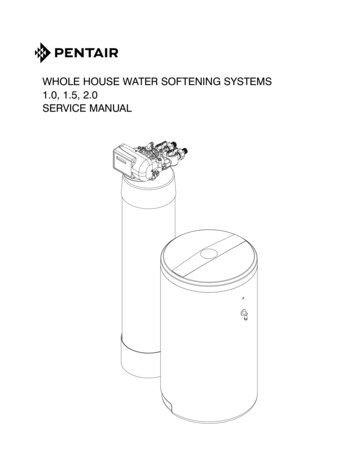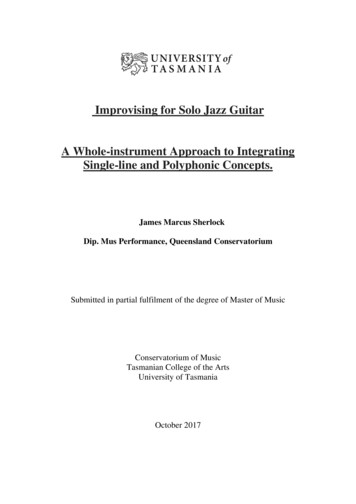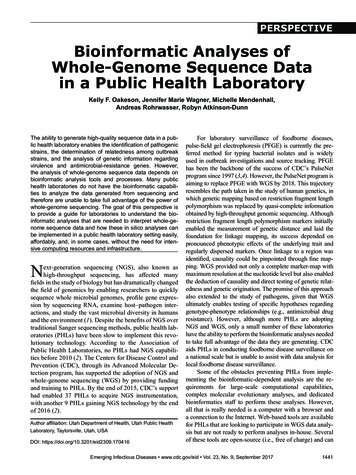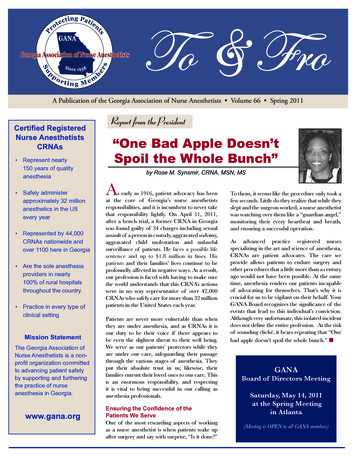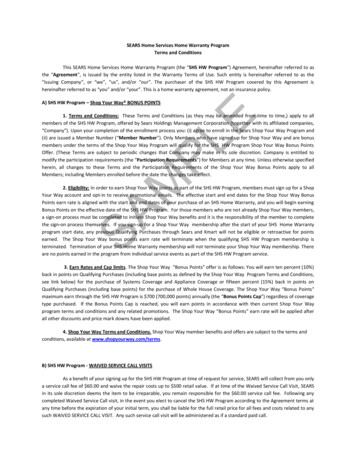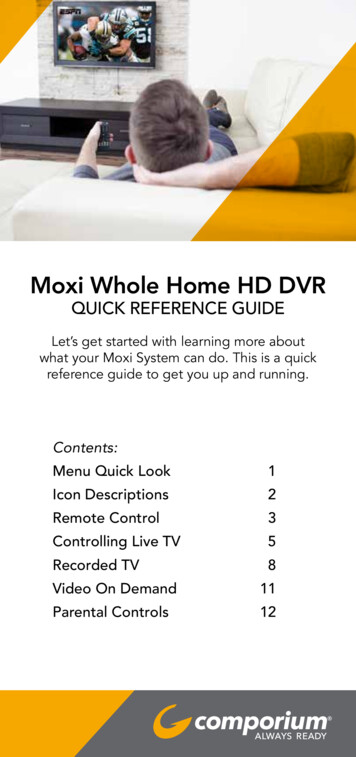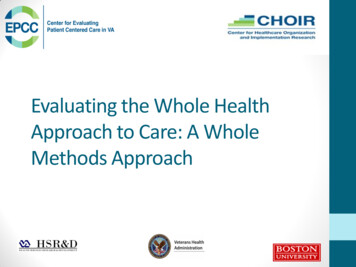
Transcription
Evaluating the Whole HealthApproach to Care: A WholeMethods Approach
Acknowledgment This work was supported by a Partnered Evaluation CenterAward #13-001 from the U.S. Department of Veterans Affairs,Office of Patient-Centered Care and Cultural Transformationand the Quality Enhancement Research Initiative Programs. The contents do not represent the views of the U.S.Department of Veterans Affairs or the United StatesGovernment No conflicts of interest
Team Gemmae M. Fix, PhD1,2,3 Donald R. Miller, ScD1,2,3 Barbara G. Bokhour, PhD1,2,3 Principal Investigator, EPCCAnna Barker, MS1,2Rendelle E. Bolton, MSW, MA1,2Kimberly L. Harvey2,4Timothy P. Hogan, PhD1,2,4Tana M. Luger, PhD, MPH5,6Therasia Roland, MSW1,2Mollie Ruben, PhD2,7Errol Baker, PhD8Mark Meterko91 Centerfor Evaluating Patient-Centered Care in VA (EPCC-VA); 2 Center for Healthcare Organization andImplementation Research (CHOIR); Edith Nourse Rogers Memorial VA Medical Center, Bedford, MA; 3 BostonUniversity School of Public Health; 4 University of Massachusetts Medical School ; 5 Pitzer College; 6 Universityof California, Los Angeles, Department of Health Policy and Management; 7Massachusetts College ofPharmacy and Health Sciences University; 8Dedicated to our colleague; 9 VHA survey methodologist
Poll Question #1: I am interested in VA dataprimarily due to my role as . Research investigator Data manager Project coordinator Program specialist or analyst Other (specify)4
Poll Question #2: My familiarity with qualitativeor mixed-methods study design is None Basic familiarity Have worked on mixed-methods/qualitative studies Have designed mixed-methods/qualitative studies5
Poll Question #3: Which of the followingbest characterizes partnered work: Operations driven. Bi-directional. Research driven.6
Presentation Goals1. Provide a brief orientation to EPCC’s work evaluatingOPCC&CT’s patient-centered care initiatives.2. Describe our rapid, mixed-methods approach to evaluatingimplementation and outcomes of Personal HealthPlanning.3. Share lessons learned about evaluating dynamic programsin partnership with operations.
What is Patient-Centered Care? Patient-Centered Care (PCC) Institute of Medicine Care that is respectful of and responsive to individual patientpreferences, needs, and values Ensures that patient values guide all clinical decisions Small, but growing evidence base Healthcare systems implementing PCC programs Requires cultural shift in care practices
Evaluation PartnersOffice of Patient-Centered Care &Cultural Transformation(OPCC&CT)
Office of Patient-Centered Care& Cultural Transformation Charged with transforming VA to a “Whole Health” model ofcare Mission is focused on transforming VA to a system thatprovides personalized, proactive, patient-driven care Changing the conversation“What's the matter WITH you?” “What matters TO you?” Implementing several PCC initiatives
Center for Evaluating Patient-CenteredCare Partnered Evaluation (EPCC) Partnered with OPCC&CT since 2013 Evaluating Patient Centered Care Initiatives in VA: Patient,Provider, Technology and Organizational Perspectives Evaluates a wide range of patient-centered care initiatives. Implementation, organizational, patient-perceptions Personal Health Planning Cornerstone of OPCC&CT’s efforts to “change the conversation”from disease focus to a whole health approach
Whole Methods Mixed Methods Whole Methods Approach More than just qualitative & quantitative data Multiple sources of data: Qualitative (interviews, observations,case study approach), quantitative, database Inter-related, complementary data Iterative, integration between qualitative and quantitativemethods.
What is a “partner”?EPCC “partner” Administrative level OPCC&CT and EPCC OPCC&CT field team and EPCC research team Site level EPCC research team and study sites Team level EPCC qualitative research team and quantitative research team
Whole Health14
Personal Health Planning VA Patient-Centered Care initiative Collaborative development of a health plan Patient identifies health goal, based on patient life context,values, preferences Series of questions designed to identify what really matters Growing evidence base
MyStory: Personal HealthInventory1.What REALLY matters to you in your life?2.What brings you a sense of joy andhappiness?3.What is your vision of your best possiblehealth?CURRENT AND DESIRED STATES:
PHP Implementation Goal of OPCC&CT was to know what the impact of PHP was onVeterans Natural experiment; Not a prescriptive rollout of evidenced-based program Sites given latitude on what and how they implemented PHP EPCC research team wanted to learn: How PHP was implemented at a range of sites,How PHP was done, in depthWhat were patients experiences with PHPWhat were the patient reported and clinical outcomes of PHP.
Study Objectives Understand what PHP looked like in practice How PHP was implemented at a range of sites How PHP was done, in depth Examine patient experiences of PHP Describe clinical outcomes associated with exposure to PHP
Study DesignI. Qualitative Evaluation of Implementation Phase 1, broad overview Phase 2, in-depth case studiesII. Quantitative Evaluation Patient surveys Intermediate clinical outcomes
I. Qualitative
What is a “partner”?EPCC “partner” Administrative level OPCC&CT and EPCC OPCC&CT field team and EPCC research team Site level EPCC research team and study sites Team level EPCC qualitative research team and quantitative research team
Study Design1.1 How PHP was implemented at a range of sites, 10 diverse sites Selection criteria: OPCC&CT input; size, location & program history Qualitative phone interviews with PHP leads1.2 How PHP was done, in depth 2 sites Selection criteria: extent of PHP program, use of innovative practices& potential to be spread Ethnographic (site visits; interviews, observation, document review) Analysis Qualitative, grounded thematic approach A priori coding, based on PHP program & theories of PCC
SiteSite CharacteristicsWhere PHP isImplementedWhich VeteransResponsible staff1Rural South Atlantic,High complexity (1c)Wellness Clinic groups;Individual health coachingPre-transplant;Health coachesHistory of substance abuse2Rural Southwest Central,High complexity (1a)Shared MedicalAppointmentsHypertension;Less complexShared MedicalAppointment Providers &Ancillary Staff3Urban New England,High complexity (1a)1 PACT teamNo acute concernsPACT MD & RN4Rural Pacific West,Low complexity (3)All PACT teamsAll PACT patientsPACT clerk, LPN, RN, &provider5Urban Southwest Central,High complexity (1b)Pain clinicChronic painPain clinic providers &ancillary staff6Urban Southwest Central,High complexity (1c)PACT;Mental HealthSerious mental illnessPeer Support Specialists inShared MedicalAppointments & IndividualAppointments7Urban New England,High complexity (1a)1 PACT team;1 Women’s Health Clinic;1 CBOCNo acute concerns1 MD in each location & RN8Rural New England,Low complexity (3)Pain clinicChronic painAll clinic team members9Urban Southeast Central,Medium complexity (2)Health coachingChronic conditionsHealth coaches10Urban Midwest,High complexity (1a)PACT teams at main facilityCBOCsAll patients interested inhealth planningPeer health coach;RN Care Manager
All patients Non-acuteappointments Diagnosis(hypertension,seriousmental illness,chronic pain)Responsible Staff Primary Care Mental Health Pain Clinic SharedMedicalAppointmentsPatient PopulationLocationPhase 1.1 Findings 1-2 people Whole team Health coach MD & RN
Phase 1.2 SitesFacilitySITE 4.Communitybased outpatientclinicPacific NWSITE 10.Large, urbanmedical centerMidwestSetting*Strong supportfrom MedicalDirector*2 leads from mainfacility*Regional support*Aligned withalready ongoinginitiativesPHPProgram*“Life Goals”*Distributed by clerks*clinicians & ancillarystaff discussthroughout appt.*Clinicians or ancillarystaff refer patient*Health Coach workswith patients*HC develop PHP &provide ongoingsupport
Phase 1.2 FindingsPatient-ProviderInteractionDevelop a Clinic CultureSupportive of PHPFacility-level FoundationSupportive of PHP
Build a Facility-level FoundationSupportive of PHP Leadership support at all levels Quality over quantity PHP information documented and communicatedSite 10 PHP in the electronic medical record (EMR) Clinical Application Coordinator (CAC) enlisted to develop an electronictemplate in EMR Entire facility had access to a patient’s PHP
Develop a Supportive Clinic Culture Involve providers in the implementation processEngage all primary care providers in PHPTrain team members responsible for PHPRaise awareness across ancillary staffSite 10 Ancillary staff (dietitian, social work, pharmacy, behavioral health) Largely unaware of PHP Developed their own care plans, in accordance with their scope of practice Care plans were not informed by or even congruent with PHPs ! dietician characterized his role by saying “[My] plan has more to dowith the goals that we [the providers] actually set for the patients. [We]make sure that they’re onboard with. I mean I’m never going to tell apatient, you know, ‘You need to do this,’ without them, you know,acquiescing to actually do it.”
Patient-Provider Interactions Orient the patientEngage patients in conversations about their prioritiesCollaboration between primary care and ancillary staffIdentify meaningful goals with actionable plansSite 4Beginning of appointment.Clerk introduces PHP & explains it is a different way of providing healthcare“[PHP\ really helps put you in the driver’s seat of your health care. For a longtime, the V! has been the driver of that bus, and that’s really not where weshould be"End of the appointment.Clerk checks the patient out.Asks if the patient has questions or issues the patient had not had theopportunity to ask.
Putting PHP into Practice (cont.) Orient the patientEngage patients in conversations about their prioritiesCollaboration between primary care and ancillary staffIdentify meaningful goals with actionable plansSite 10PatientMade PHP appointment focused on smoking cessationPrevious day, had emergency appointment for high blood glucoseAppointmentNurse framed the appointmentHealth coach & nurse ask patient about his daily life (not smoking)Daily life discussed ; marked by when and where the patient smokedPlanCollaboratively decided to reduce smoking during work breaksHealth coach & nurse suggested strategies– which the patient connected todiabetes management
Recommendations for Implementing PHP1. Develop a local vision, including facility-level strategicplanning and self-reflection2. Define roles and communication practices across the team3. Create infrastructure to support the PHP process, built onexisting processes and attentive to patient flow4. Conduct iterative rounds of piloting to incorporate staff,provider and patient needs5. Foster an organizational climate that supports PHP, such asidentifying and supporting PCC champions
What is a “partner”?EPCC “partner” Administrative level OPCC&CT and EPCC OPCC&CT field team and EPCC research team Site level EPCC research team and study sites Team level EPCC qualitative research team and quantitative research team
II. Quantitative
Aims and Approaches Assess veteran perceptions of the Personal Health Planning(PHP) Process and its impact on patient-level outcomesVeteran Experience Survey Evaluate effects of PHP on clinical outcomes over timeTime-series analysis of selected clinical measures
Veteran Experience SurveySurvey Measures of the PHP Process Derived from Qualitative WorkPersonal Health GoalsActions by VA primary care team and health coach to help reach personal health goalsHelpfulness of specific programs and services at site in reaching personal health goalsExperiences in personal health planningSatisfaction with personal health planningAdditional Measures – Previously Developed, Validated, and UsedPatient Experience CategoryMeasures UsedProcess of CareCommunication Assessment Tool (CAT), CollaboRATESelf-Reported Health and Functional StatusPROMIS (Patient Reported Outcomes MeasurementInformation System)Self-EfficacyChronic Disease Self-Efficacy ScalePatient’s Confidence in Managing HealthPatient Activation Measure (PAM)VA ServicesServices offered at outpatient sitesSociodemographicsGeneral health, sex, age, social conditions, etc.
Survey Methods Conducted at the 2 PHP sites with the qualitative evaluationand 2 comparison sites similar in region, size, and complexity. As example, presenting results from one PHP site and itscomparison site (urban Midwest) Survey mailed to patients along with a 5 CVS gift card asincentive; reminder card sent to non-respondents Survey samples Identified by healthcare teams PHP site- 304 outpatients - 168 completed surveys (55%) Comparison - 304 outpatients - 149 completed surveys (49%)
Veteran Experience Survey at PHP SiteTop 10 Personal Health Goals1) Get more exercise2) Eat more healthy food3) Manage long-term health condition4) Lower blood pressure or cholesterol5) Lose weight6) Improve my sleep and feel more rested7) Become more involved in my health care8) Manage my anxiety or depression9) Manage my pain10) Take my medications when I shouldN 150
Veteran Experience Survey at PHP SiteHow VA primary care team or health coach helpedveterans reach their personal health goalsReferred me to another VA professionalRecommended a VA class/activityProvided me with encouragement and supportHelped motivate meGave me educational materialsHelped connect me with a specialist or serviceHelped me set realistic/concrete goalsHelped me identify and overcome obstaclesGave me the confidence to build additional skillsHelped me stay accountable to action plan0%10%20%30%40%50%60%70%Veterans received broad and varied support in reaching health goals
Veteran Experience Survey at PHP SiteExperiences of Veterans in Personal Health Planning88% Personal health goal is important to health and well-being75% Would recommend setting a personal health goal74% Had enough say in selecting a personal health goal73% Made progress toward reaching personal health goal72% Someone followed up to discuss progress on personal health goal70% Often discuss personal health goal at visits with VA primary careteam or coach69% Relationship with VA health care team or health coach was helpfulin making progress towards personal health goal68% Choosing a personal health goal improved my health and well-beingVeterans’ experiences were generally favorable in support of reaching health goals
Veteran Experience Survey at PHP SiteCorrelations of Veterans’ Experiences in PHP withPatient-Reported OutcomesPatient-reported outcomes from the survey CollaboRATEPromis10SelfefficacyPAM 13Personal health goal is important to health and well-beingWould recommend setting a personal health goalHad enough say in selecting a personal health goalMade progress toward reaching personal health goalSomeone followed up to discuss progress on personal healthgoalOften discuss personal health goal at visits with VA primarycare team or coachRelationship with VA health care team or health coach washelpful in making progress towards personal health goalChoosing a personal health goal improved my health andwell-being0.05 p 0.010.01 p 0.001P 0.001Veterans’ experiences were highly correlated with patient-reported outcomes
Veteran Experience SurveySite Comparisons of Patient-Reported OutcomesPatient-reported outcomes from the surveyDifferencebetween sitesCollaboRATE: Patient-centered communication/involvementN.S.PROMIS: Physical FunctionN.S.PROMIS: AnxietyN.S.PROMIS: DepressionN.S.PROMIS: FatigueN.S.PROMIS: Sleep DisturbanceN.S.PROMIS: Social FunctionN.S.PROMIS: Pain InterferenceN.S.PROMIS: Pain IntensityN.S.Self-Efficacy in chronic disease careN.S.PAM: Patient activationN.S.No differences between PHP and comparison sites in patient-reported outcomes
Time-series analysis of clinical measures Clinical Measures Body weight (BMI)Blood pressureLDLHbA1C (glycemic control) Analysis Serial measures from 24 months before & after initial PHP visit Trends in measures; interrupted time-serial analysis; sitecomparisons Analyses are on-going; no results to date
Summary Veterans had a range of personal health goals Veterans report experiencing the PHP process as positive collaborative, patient-centered, and important to their health. Veterans experiences with PHP were related to better patientreported outcomes No short-term measurable differences between sites in selfreported outcomes, such as health status, functional status . Awaiting results of analysis of clinical measures More rigorous design may reveal potential benefits of PHP – Comparison of pre-PHP to post-PHP results PHP over time at multiple visits Longer follow-up for self-reported and clinical measures
III. Working in Partnership
Deliverable andDateReach: Internal VA calls, meetings &conferencesDissemination: Presentations and PublicationsOutside the VA (including drafts & submissions)WRITTEN & ORAL PHP ImplementationInterim Report(5/8/15)BY EPCC COI Call (10/16/15) Integrative HealthCOP Call (2/11/16) VIRec CyberSeminar.10/18/16.PRESENTATIONS Examining theImplementation of V!’sPersonal Health PlanningTool for Veteran-CenteredHealthcare (Fix, et. al,HSR&D oral presentation,7/9/15) Understanding PersonalHealth Planning Across VA(Bolton, et. al, HSR&D oralpresentation, 7/9/15) Continuing theConversation: OngoingFollow-up of PersonalizedHealth Plans (Luger, et. al,HSR&D oral presentation,7/9/15) Striking the Balance: A CaseStudy in Exemplary PatientCentered Communication(Fix, et. al, ICCH oralpresentation, 10/25/15) Implementing PersonalHealth Planning in VA:Results of a Qualitative,Multisite Evaluation (Fix, et.al., oral presentation atAcademy Health, 6/26/16) PHP ImplementationFinal Report,“!pproaches toPersonal HealthPlanning in VA:Results of a multisiteevaluation ”(12/23/15)BY OPCC&CT OPCC&CT StaffMeeting (5/15) PHI Community ofPractice (12/11/15) VA Pulse (1/16) Whole HealthCommunity ofPractice (1/16) Email to VeteransHealth mailing list,“Engaging Veteranswith Personal HealthPlanning” (3/16)PUBLICATIONS Ongoing Follow-up ofPatient’s PersonalizedHealth Plans: AnExamination of VA Practicesand Lessons Learned (Luger,et. al., draft) Implementing PersonalHealth Planning in VA:Results of a Qualitative,Multisite Evaluation (Fix, et.al., draft) Bolton, R., Bokhour, B.G.,Hogan, T.P., Luger, T.M., Fix,G.M. (In Preparation).Patient-centeredapproaches to healthplanning in primary careteams.
Strengths & Challenges Strengths Partnering iterative discussions between OPCC&CT & EPCCRapid, flexible study designHolistic, integrated mixed methods study designDesign allowed for: OPCC&CT and EPCC to understand what the sites are doing to adapt PHPto their context. Development of survey questions/measures Interpret outcomes. Challenges Trying to measure real world, natural experiment messyPHP does not always equal PHPNeed a large, dedicated teamStreamlining communication amongst all the partners
Strategies for conducting rapid,partner-aligned work Prioritize study aims over initial proposed plan “Team science” Bi-directional communication between partners Utilize reflective processes as a team Rapid data collection and analysis procedures BUT maintain rigor through adherence to researchmethodological principles
Conclusions Need for multiple kinds of data to understand a complexintervention Informs Operations/Front line employees Evaluators need to be flexible and adaptable Incorporating partner feedback Efficient use of resources Next steps EPCC FY’ 16 & ’17 Whole Health Eva
Not a prescriptive rollout of evidenced-based program Sites given latitude on what and how they implemented PHP EPCC research team wanted to learn: How PHP was implemented at a range of sites, How PHP was

